University Nursing Case Study: Crohn's Disease Management
VerifiedAdded on 2022/08/21
|6
|1613
|11
Case Study
AI Summary
This nursing case study analyzes a patient, Jordan, diagnosed with Crohn's disease, exploring the disease's impact on appetite, symptoms such as abscesses and strictures, and the underlying inflammatory processes. The case study discusses the role of morphine for pain management and the develop...
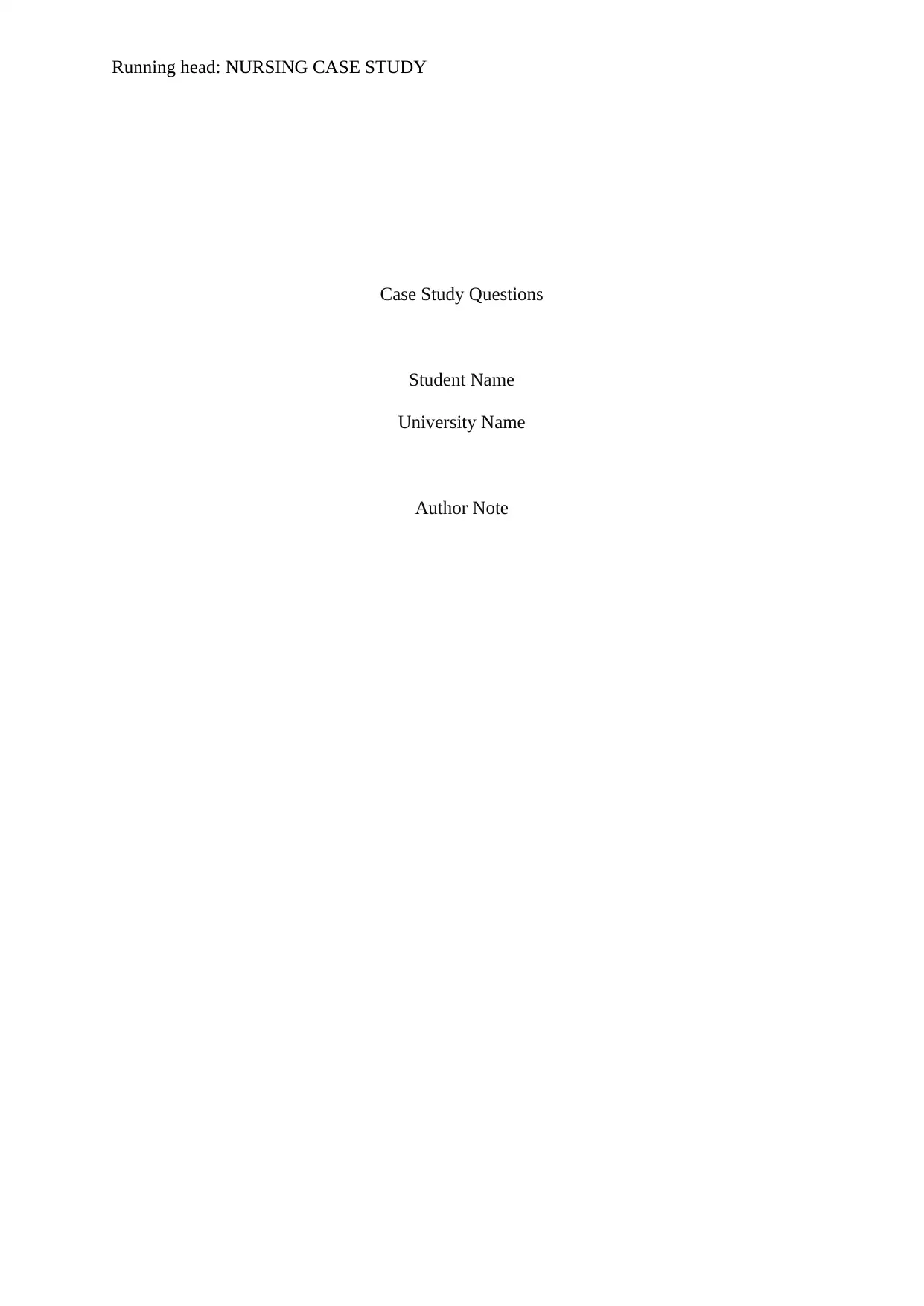
Running head: NURSING CASE STUDY
Case Study Questions
Student Name
University Name
Author Note
Case Study Questions
Student Name
University Name
Author Note
Paraphrase This Document
Need a fresh take? Get an instant paraphrase of this document with our AI Paraphraser
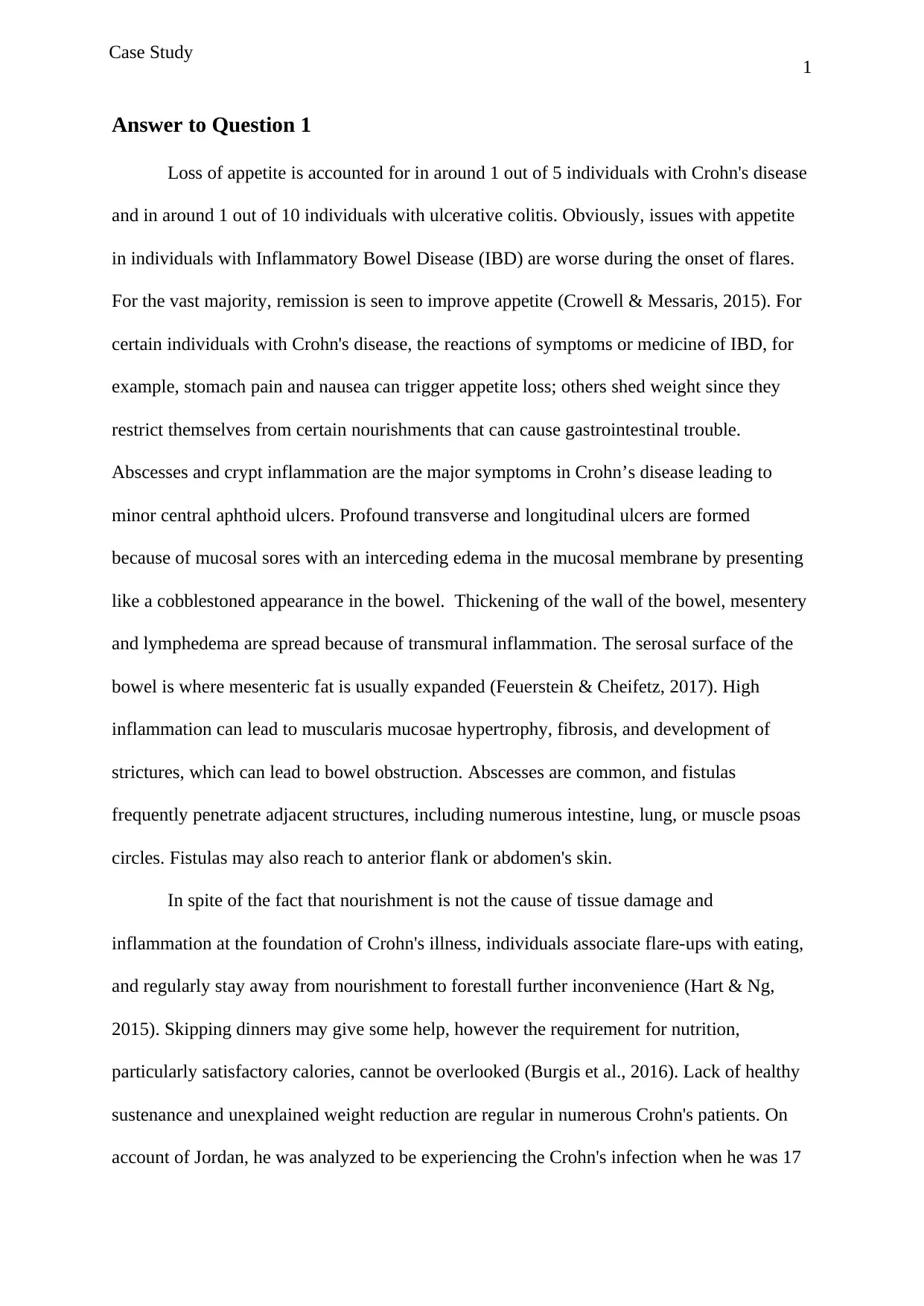
1
Answer to Question 1
Loss of appetite is accounted for in around 1 out of 5 individuals with Crohn's disease
and in around 1 out of 10 individuals with ulcerative colitis. Obviously, issues with appetite
in individuals with Inflammatory Bowel Disease (IBD) are worse during the onset of flares.
For the vast majority, remission is seen to improve appetite (Crowell & Messaris, 2015). For
certain individuals with Crohn's disease, the reactions of symptoms or medicine of IBD, for
example, stomach pain and nausea can trigger appetite loss; others shed weight since they
restrict themselves from certain nourishments that can cause gastrointestinal trouble.
Abscesses and crypt inflammation are the major symptoms in Crohn’s disease leading to
minor central aphthoid ulcers. Profound transverse and longitudinal ulcers are formed
because of mucosal sores with an interceding edema in the mucosal membrane by presenting
like a cobblestoned appearance in the bowel. Thickening of the wall of the bowel, mesentery
and lymphedema are spread because of transmural inflammation. The serosal surface of the
bowel is where mesenteric fat is usually expanded (Feuerstein & Cheifetz, 2017). High
inflammation can lead to muscularis mucosae hypertrophy, fibrosis, and development of
strictures, which can lead to bowel obstruction. Abscesses are common, and fistulas
frequently penetrate adjacent structures, including numerous intestine, lung, or muscle psoas
circles. Fistulas may also reach to anterior flank or abdomen's skin.
In spite of the fact that nourishment is not the cause of tissue damage and
inflammation at the foundation of Crohn's illness, individuals associate flare-ups with eating,
and regularly stay away from nourishment to forestall further inconvenience (Hart & Ng,
2015). Skipping dinners may give some help, however the requirement for nutrition,
particularly satisfactory calories, cannot be overlooked (Burgis et al., 2016). Lack of healthy
sustenance and unexplained weight reduction are regular in numerous Crohn's patients. On
account of Jordan, he was analyzed to be experiencing the Crohn's infection when he was 17
Case Study
Answer to Question 1
Loss of appetite is accounted for in around 1 out of 5 individuals with Crohn's disease
and in around 1 out of 10 individuals with ulcerative colitis. Obviously, issues with appetite
in individuals with Inflammatory Bowel Disease (IBD) are worse during the onset of flares.
For the vast majority, remission is seen to improve appetite (Crowell & Messaris, 2015). For
certain individuals with Crohn's disease, the reactions of symptoms or medicine of IBD, for
example, stomach pain and nausea can trigger appetite loss; others shed weight since they
restrict themselves from certain nourishments that can cause gastrointestinal trouble.
Abscesses and crypt inflammation are the major symptoms in Crohn’s disease leading to
minor central aphthoid ulcers. Profound transverse and longitudinal ulcers are formed
because of mucosal sores with an interceding edema in the mucosal membrane by presenting
like a cobblestoned appearance in the bowel. Thickening of the wall of the bowel, mesentery
and lymphedema are spread because of transmural inflammation. The serosal surface of the
bowel is where mesenteric fat is usually expanded (Feuerstein & Cheifetz, 2017). High
inflammation can lead to muscularis mucosae hypertrophy, fibrosis, and development of
strictures, which can lead to bowel obstruction. Abscesses are common, and fistulas
frequently penetrate adjacent structures, including numerous intestine, lung, or muscle psoas
circles. Fistulas may also reach to anterior flank or abdomen's skin.
In spite of the fact that nourishment is not the cause of tissue damage and
inflammation at the foundation of Crohn's illness, individuals associate flare-ups with eating,
and regularly stay away from nourishment to forestall further inconvenience (Hart & Ng,
2015). Skipping dinners may give some help, however the requirement for nutrition,
particularly satisfactory calories, cannot be overlooked (Burgis et al., 2016). Lack of healthy
sustenance and unexplained weight reduction are regular in numerous Crohn's patients. On
account of Jordan, he was analyzed to be experiencing the Crohn's infection when he was 17
Case Study
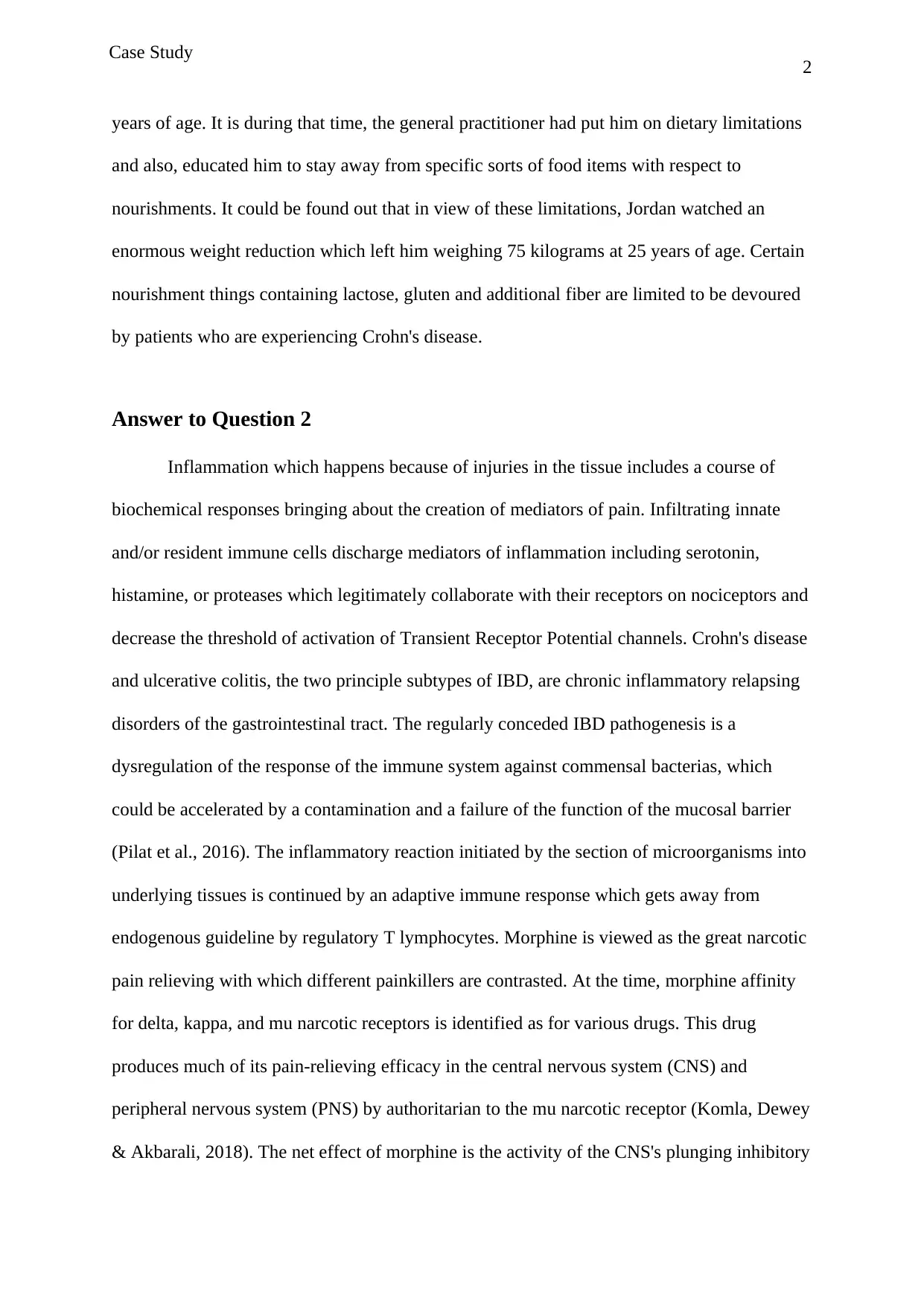
2
years of age. It is during that time, the general practitioner had put him on dietary limitations
and also, educated him to stay away from specific sorts of food items with respect to
nourishments. It could be found out that in view of these limitations, Jordan watched an
enormous weight reduction which left him weighing 75 kilograms at 25 years of age. Certain
nourishment things containing lactose, gluten and additional fiber are limited to be devoured
by patients who are experiencing Crohn's disease.
Answer to Question 2
Inflammation which happens because of injuries in the tissue includes a course of
biochemical responses bringing about the creation of mediators of pain. Infiltrating innate
and/or resident immune cells discharge mediators of inflammation including serotonin,
histamine, or proteases which legitimately collaborate with their receptors on nociceptors and
decrease the threshold of activation of Transient Receptor Potential channels. Crohn's disease
and ulcerative colitis, the two principle subtypes of IBD, are chronic inflammatory relapsing
disorders of the gastrointestinal tract. The regularly conceded IBD pathogenesis is a
dysregulation of the response of the immune system against commensal bacterias, which
could be accelerated by a contamination and a failure of the function of the mucosal barrier
(Pilat et al., 2016). The inflammatory reaction initiated by the section of microorganisms into
underlying tissues is continued by an adaptive immune response which gets away from
endogenous guideline by regulatory T lymphocytes. Morphine is viewed as the great narcotic
pain relieving with which different painkillers are contrasted. At the time, morphine affinity
for delta, kappa, and mu narcotic receptors is identified as for various drugs. This drug
produces much of its pain-relieving efficacy in the central nervous system (CNS) and
peripheral nervous system (PNS) by authoritarian to the mu narcotic receptor (Komla, Dewey
& Akbarali, 2018). The net effect of morphine is the activity of the CNS's plunging inhibitory
Case Study
years of age. It is during that time, the general practitioner had put him on dietary limitations
and also, educated him to stay away from specific sorts of food items with respect to
nourishments. It could be found out that in view of these limitations, Jordan watched an
enormous weight reduction which left him weighing 75 kilograms at 25 years of age. Certain
nourishment things containing lactose, gluten and additional fiber are limited to be devoured
by patients who are experiencing Crohn's disease.
Answer to Question 2
Inflammation which happens because of injuries in the tissue includes a course of
biochemical responses bringing about the creation of mediators of pain. Infiltrating innate
and/or resident immune cells discharge mediators of inflammation including serotonin,
histamine, or proteases which legitimately collaborate with their receptors on nociceptors and
decrease the threshold of activation of Transient Receptor Potential channels. Crohn's disease
and ulcerative colitis, the two principle subtypes of IBD, are chronic inflammatory relapsing
disorders of the gastrointestinal tract. The regularly conceded IBD pathogenesis is a
dysregulation of the response of the immune system against commensal bacterias, which
could be accelerated by a contamination and a failure of the function of the mucosal barrier
(Pilat et al., 2016). The inflammatory reaction initiated by the section of microorganisms into
underlying tissues is continued by an adaptive immune response which gets away from
endogenous guideline by regulatory T lymphocytes. Morphine is viewed as the great narcotic
pain relieving with which different painkillers are contrasted. At the time, morphine affinity
for delta, kappa, and mu narcotic receptors is identified as for various drugs. This drug
produces much of its pain-relieving efficacy in the central nervous system (CNS) and
peripheral nervous system (PNS) by authoritarian to the mu narcotic receptor (Komla, Dewey
& Akbarali, 2018). The net effect of morphine is the activity of the CNS's plunging inhibitory
Case Study
⊘ This is a preview!⊘
Do you want full access?
Subscribe today to unlock all pages.

Trusted by 1+ million students worldwide
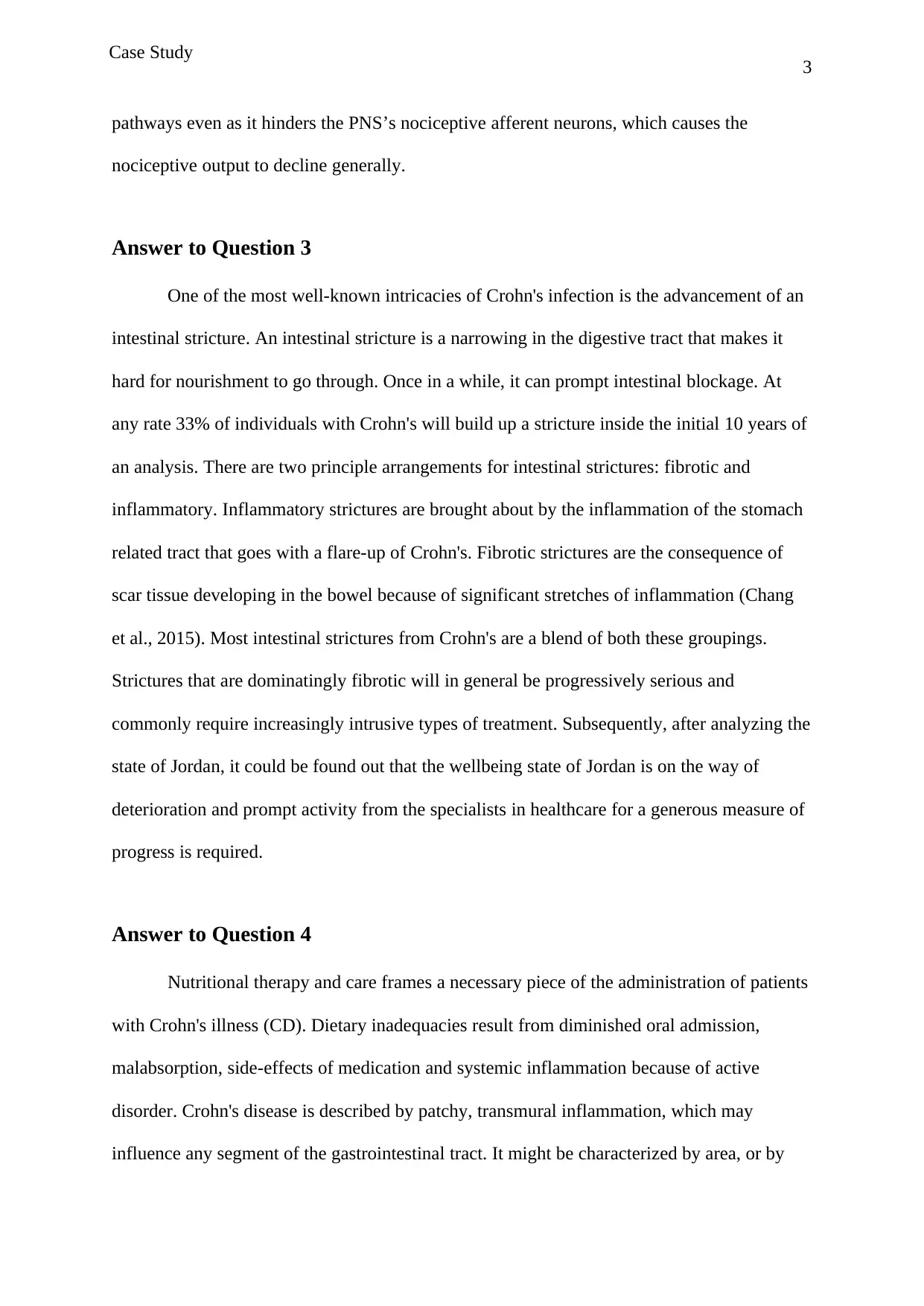
3
pathways even as it hinders the PNS’s nociceptive afferent neurons, which causes the
nociceptive output to decline generally.
Answer to Question 3
One of the most well-known intricacies of Crohn's infection is the advancement of an
intestinal stricture. An intestinal stricture is a narrowing in the digestive tract that makes it
hard for nourishment to go through. Once in a while, it can prompt intestinal blockage. At
any rate 33% of individuals with Crohn's will build up a stricture inside the initial 10 years of
an analysis. There are two principle arrangements for intestinal strictures: fibrotic and
inflammatory. Inflammatory strictures are brought about by the inflammation of the stomach
related tract that goes with a flare-up of Crohn's. Fibrotic strictures are the consequence of
scar tissue developing in the bowel because of significant stretches of inflammation (Chang
et al., 2015). Most intestinal strictures from Crohn's are a blend of both these groupings.
Strictures that are dominatingly fibrotic will in general be progressively serious and
commonly require increasingly intrusive types of treatment. Subsequently, after analyzing the
state of Jordan, it could be found out that the wellbeing state of Jordan is on the way of
deterioration and prompt activity from the specialists in healthcare for a generous measure of
progress is required.
Answer to Question 4
Nutritional therapy and care frames a necessary piece of the administration of patients
with Crohn's illness (CD). Dietary inadequacies result from diminished oral admission,
malabsorption, side-effects of medication and systemic inflammation because of active
disorder. Crohn's disease is described by patchy, transmural inflammation, which may
influence any segment of the gastrointestinal tract. It might be characterized by area, or by
Case Study
pathways even as it hinders the PNS’s nociceptive afferent neurons, which causes the
nociceptive output to decline generally.
Answer to Question 3
One of the most well-known intricacies of Crohn's infection is the advancement of an
intestinal stricture. An intestinal stricture is a narrowing in the digestive tract that makes it
hard for nourishment to go through. Once in a while, it can prompt intestinal blockage. At
any rate 33% of individuals with Crohn's will build up a stricture inside the initial 10 years of
an analysis. There are two principle arrangements for intestinal strictures: fibrotic and
inflammatory. Inflammatory strictures are brought about by the inflammation of the stomach
related tract that goes with a flare-up of Crohn's. Fibrotic strictures are the consequence of
scar tissue developing in the bowel because of significant stretches of inflammation (Chang
et al., 2015). Most intestinal strictures from Crohn's are a blend of both these groupings.
Strictures that are dominatingly fibrotic will in general be progressively serious and
commonly require increasingly intrusive types of treatment. Subsequently, after analyzing the
state of Jordan, it could be found out that the wellbeing state of Jordan is on the way of
deterioration and prompt activity from the specialists in healthcare for a generous measure of
progress is required.
Answer to Question 4
Nutritional therapy and care frames a necessary piece of the administration of patients
with Crohn's illness (CD). Dietary inadequacies result from diminished oral admission,
malabsorption, side-effects of medication and systemic inflammation because of active
disorder. Crohn's disease is described by patchy, transmural inflammation, which may
influence any segment of the gastrointestinal tract. It might be characterized by area, or by
Case Study
Paraphrase This Document
Need a fresh take? Get an instant paraphrase of this document with our AI Paraphraser
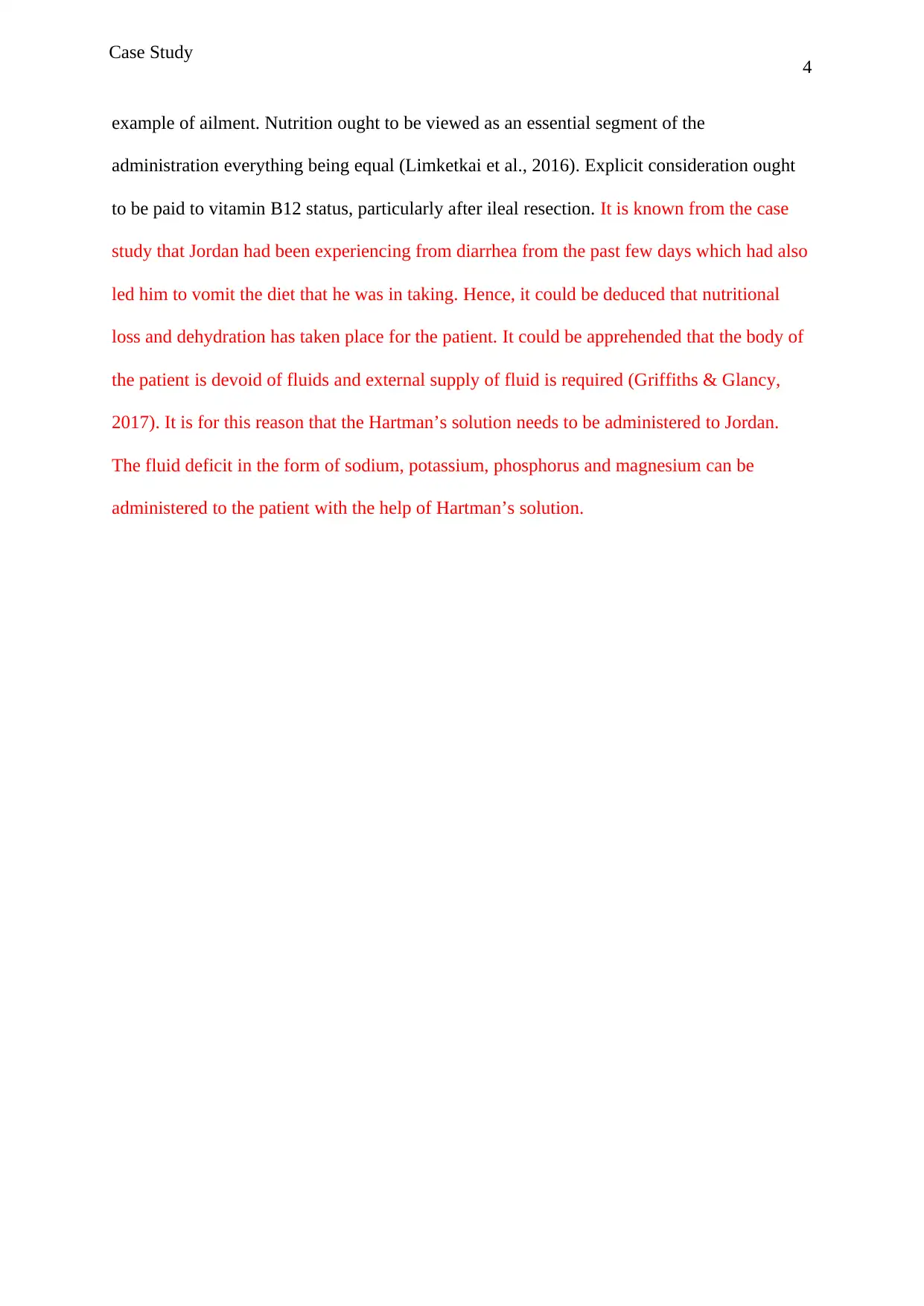
4
example of ailment. Nutrition ought to be viewed as an essential segment of the
administration everything being equal (Limketkai et al., 2016). Explicit consideration ought
to be paid to vitamin B12 status, particularly after ileal resection. It is known from the case
study that Jordan had been experiencing from diarrhea from the past few days which had also
led him to vomit the diet that he was in taking. Hence, it could be deduced that nutritional
loss and dehydration has taken place for the patient. It could be apprehended that the body of
the patient is devoid of fluids and external supply of fluid is required (Griffiths & Glancy,
2017). It is for this reason that the Hartman’s solution needs to be administered to Jordan.
The fluid deficit in the form of sodium, potassium, phosphorus and magnesium can be
administered to the patient with the help of Hartman’s solution.
Case Study
example of ailment. Nutrition ought to be viewed as an essential segment of the
administration everything being equal (Limketkai et al., 2016). Explicit consideration ought
to be paid to vitamin B12 status, particularly after ileal resection. It is known from the case
study that Jordan had been experiencing from diarrhea from the past few days which had also
led him to vomit the diet that he was in taking. Hence, it could be deduced that nutritional
loss and dehydration has taken place for the patient. It could be apprehended that the body of
the patient is devoid of fluids and external supply of fluid is required (Griffiths & Glancy,
2017). It is for this reason that the Hartman’s solution needs to be administered to Jordan.
The fluid deficit in the form of sodium, potassium, phosphorus and magnesium can be
administered to the patient with the help of Hartman’s solution.
Case Study
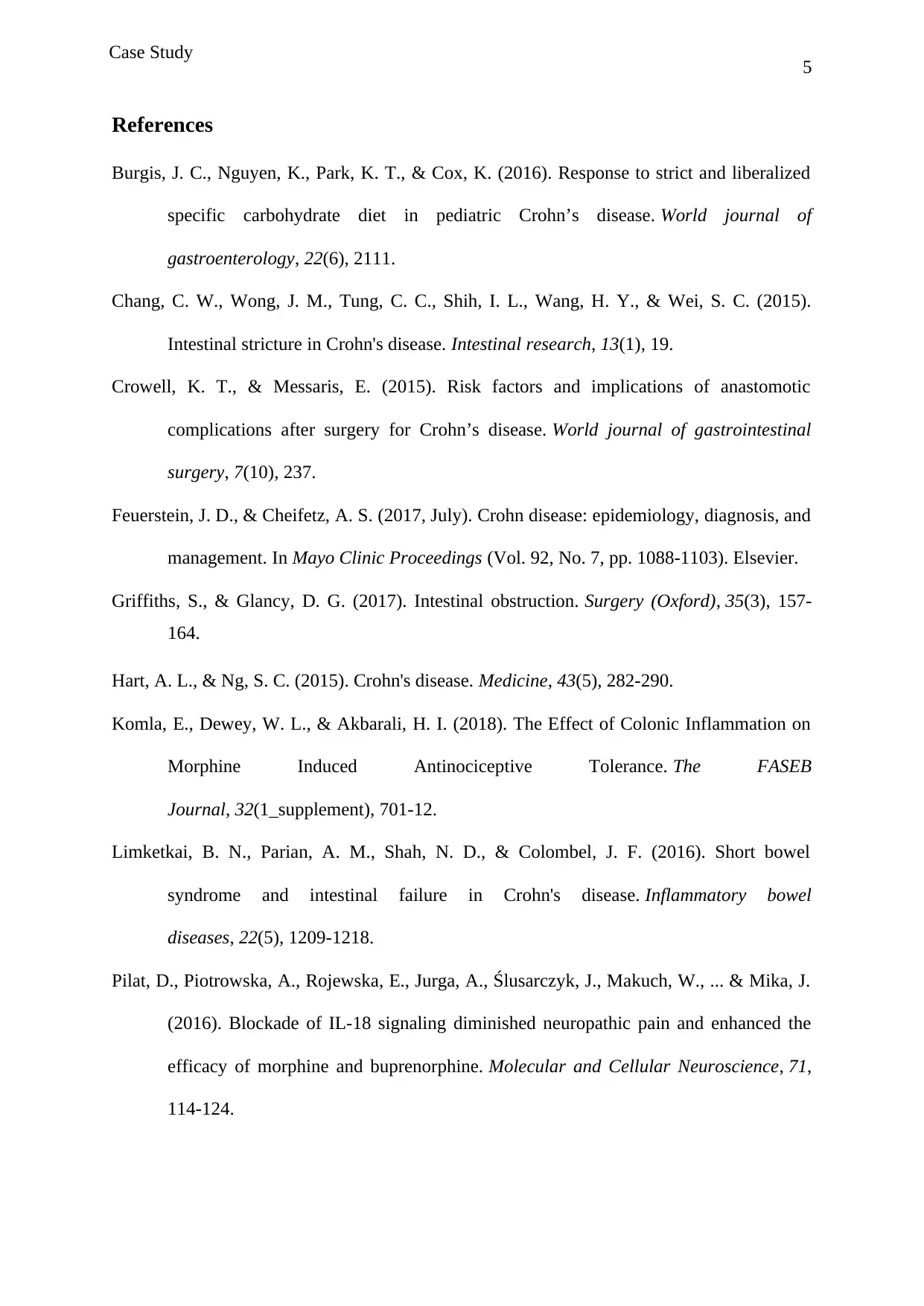
5
References
Burgis, J. C., Nguyen, K., Park, K. T., & Cox, K. (2016). Response to strict and liberalized
specific carbohydrate diet in pediatric Crohn’s disease. World journal of
gastroenterology, 22(6), 2111.
Chang, C. W., Wong, J. M., Tung, C. C., Shih, I. L., Wang, H. Y., & Wei, S. C. (2015).
Intestinal stricture in Crohn's disease. Intestinal research, 13(1), 19.
Crowell, K. T., & Messaris, E. (2015). Risk factors and implications of anastomotic
complications after surgery for Crohn’s disease. World journal of gastrointestinal
surgery, 7(10), 237.
Feuerstein, J. D., & Cheifetz, A. S. (2017, July). Crohn disease: epidemiology, diagnosis, and
management. In Mayo Clinic Proceedings (Vol. 92, No. 7, pp. 1088-1103). Elsevier.
Griffiths, S., & Glancy, D. G. (2017). Intestinal obstruction. Surgery (Oxford), 35(3), 157-
164.
Hart, A. L., & Ng, S. C. (2015). Crohn's disease. Medicine, 43(5), 282-290.
Komla, E., Dewey, W. L., & Akbarali, H. I. (2018). The Effect of Colonic Inflammation on
Morphine Induced Antinociceptive Tolerance. The FASEB
Journal, 32(1_supplement), 701-12.
Limketkai, B. N., Parian, A. M., Shah, N. D., & Colombel, J. F. (2016). Short bowel
syndrome and intestinal failure in Crohn's disease. Inflammatory bowel
diseases, 22(5), 1209-1218.
Pilat, D., Piotrowska, A., Rojewska, E., Jurga, A., Ślusarczyk, J., Makuch, W., ... & Mika, J.
(2016). Blockade of IL-18 signaling diminished neuropathic pain and enhanced the
efficacy of morphine and buprenorphine. Molecular and Cellular Neuroscience, 71,
114-124.
Case Study
References
Burgis, J. C., Nguyen, K., Park, K. T., & Cox, K. (2016). Response to strict and liberalized
specific carbohydrate diet in pediatric Crohn’s disease. World journal of
gastroenterology, 22(6), 2111.
Chang, C. W., Wong, J. M., Tung, C. C., Shih, I. L., Wang, H. Y., & Wei, S. C. (2015).
Intestinal stricture in Crohn's disease. Intestinal research, 13(1), 19.
Crowell, K. T., & Messaris, E. (2015). Risk factors and implications of anastomotic
complications after surgery for Crohn’s disease. World journal of gastrointestinal
surgery, 7(10), 237.
Feuerstein, J. D., & Cheifetz, A. S. (2017, July). Crohn disease: epidemiology, diagnosis, and
management. In Mayo Clinic Proceedings (Vol. 92, No. 7, pp. 1088-1103). Elsevier.
Griffiths, S., & Glancy, D. G. (2017). Intestinal obstruction. Surgery (Oxford), 35(3), 157-
164.
Hart, A. L., & Ng, S. C. (2015). Crohn's disease. Medicine, 43(5), 282-290.
Komla, E., Dewey, W. L., & Akbarali, H. I. (2018). The Effect of Colonic Inflammation on
Morphine Induced Antinociceptive Tolerance. The FASEB
Journal, 32(1_supplement), 701-12.
Limketkai, B. N., Parian, A. M., Shah, N. D., & Colombel, J. F. (2016). Short bowel
syndrome and intestinal failure in Crohn's disease. Inflammatory bowel
diseases, 22(5), 1209-1218.
Pilat, D., Piotrowska, A., Rojewska, E., Jurga, A., Ślusarczyk, J., Makuch, W., ... & Mika, J.
(2016). Blockade of IL-18 signaling diminished neuropathic pain and enhanced the
efficacy of morphine and buprenorphine. Molecular and Cellular Neuroscience, 71,
114-124.
Case Study
⊘ This is a preview!⊘
Do you want full access?
Subscribe today to unlock all pages.

Trusted by 1+ million students worldwide
1 out of 6
Related Documents
Your All-in-One AI-Powered Toolkit for Academic Success.
+13062052269
info@desklib.com
Available 24*7 on WhatsApp / Email
![[object Object]](/_next/static/media/star-bottom.7253800d.svg)
Unlock your academic potential
© 2024 | Zucol Services PVT LTD | All rights reserved.





